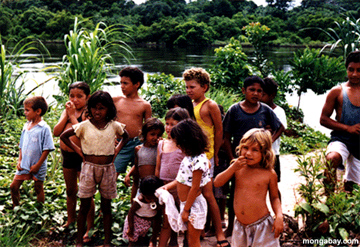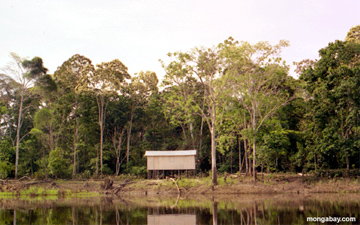Lack of school access and higher costs of trade are driving an exodus from remote areas in the Amazon, a new study published in Population & Environment reveals.
The research sheds light on to why people are leaving remote forest areas. It follows an earlier publication indicating that migration away from remote rural areas may have repercussions on deforestation. “Understanding why people are leaving is key to predicting future environmental change,” the paper explained.
There are many advantages to living in remote areas in the Brazilian Amazon. Land is freely available to those who want to claim it and people have better access to wildlife and natural resources. Closer to town, unclaimed land is scarce, fields are flooded in the wet season and unemployment is high.

Member of a remote community in the Brazilian Amazon. Photo by Luke Parry, Lancaster University. |
So why are people leaving? Luke Perry and his colleagues interviewed households along the river, starting from the most remote settlement upstream.
Living in remote areas comes with tough challenges, the study highlights. “Remote areas are valued for their abundance of land and natural resources, but in the contemporary post-rubber era these advantages are not perceived to compensate for the disadvantages of inhabiting headwater regions,” the authors write.
Lack of access to public services, and schools in particular, was found to be a major reason for leaving remote areas. “Completing secondary education in Latin America provides a child with a fair chance of escaping poverty,” Perry and his colleagues report. “It is therefore unsurprising that parents in settlements without a school wished to relocate their family to an urban area, even if employment is problematic at least in the short term.” They also cite one respondent: “This community only exists because of the school.”
Living upriver also makes trade more difficult and more costly. Whilst items brought by traders, such as sugar, cooking oil and salt, are twice as expensive as in urban supermarkets, cultivators are forced to sell their products at a low price to compensate for the high transport cost.

Children of Amazon river dwellers or caboclos in the Brazilian Amazon. Photo by Rhett A. Butler. |
In addition, many social benefits are not accessible to people in more remote areas. Under a poverty-reduction scheme called Bolsa Família, poor people are entitled to receive subsidy from the Brazilian government, but these need to be collected from urban centers. The high transport costs often make it not financially interesting to collect the money.
This also means that conservation subsidies such as the Bolsa Floresta payments for ecosystem services program, initially proposed as a way to reduce exodus by providing an income-stream in remote areas, would be severely impaired by the high transport costs.
Migration to the state of Amazonas in Brazil has historically been driven by rubber extraction. However in the 1990s international demand for rubber collapsed and migration out of remote areas began. “Amazonian river-dwellers, who are often former rubber-tappers or their descendants, remain largely forgotten in migration analyses, despite the fact that they number several million people,” write the authors. There are concerns over the social implications of migration to urban areas, as in other parts of Brazil it has resulted in socio-economic inequality, poverty, violence, and unemployment.

|
So what is the solution? Considering the lack of school is a major reason for leaving remote areas, providing schools in these areas may seem like the logical policy. However Perry and his colleagues provide a word of caution: “It may not be possible to effectively supply competent teachers to remote areas
in which human settlements are small and sparsely scattered, and transport is costly.” In addition, they note that education increases chances of rural employment, and so may further drive rural exodus in the future.
“This research raises as many questions as it answers,” they conclude.
Past projects may provide a useful model. In the Upper Solimões region of the Amazonas, Alencar and his colleagues reported in 2005 that the formation of rural education poles providing education beyond the 8th grade has been credited with the provision of rural jobs such as boat drivers and school assistants. It is credited with helping prevent further rural-urban migration.
Related articles







